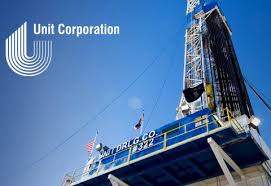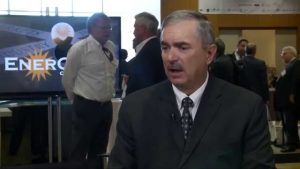
Tulsa-based Unit Corporation reported a second quarter net loss of $8.5 million or 16 cents a share compared to $5.8 million in net income and 11 cents a share for the second quarter of 2018. The company blamed the loss on the declining prices of natural gas liquids.
The company’s adjusted net loss for the quarter was $12.9 million or 24 cents a diluted share compared to adjusted net income attributable to Unit of $11.3 million or 21 cents a diluted share for the same quarter of 2018.
Total revenues for the quarter were $165.1 million (47% oil and natural gas, 26% contract drilling, and 27% mid-stream), compared to $203.3 million (50% oil and natural gas, 23% contract drilling, and 27% mid-stream) for the second quarter of 2018. Adjusted EBITDA attributable to Unit was $59.3 million, or $1.12 per diluted share (see non-GAAP financial measures below).
Oil and natural gas segment:
- Exploration efforts continue to focus on increasing oil production with second quarter 2019 oil production increasing 6% over first quarter 2019.
- In the Red Fork play, the Wingard Farms 2128 well’s peak 24-hour IP was 2,850 barrels of oil equivalent (Boe) (80% oil).
- In the Red Fork play, the Schrock 2215 well, which started production in October 2018, is producing 600 Boe per day (52% oil) and has cumulatively produced 420 thousand barrels of oil equivalent (MBoe) as of June 30, 2019.
- Approximately 2,100 net acres were added to the Penn Sands prospect area inclusive of both Marchand and Red Fork prospects.
Contract drilling segment:
- BOSS drilling rigs continue to be 100% contracted.
- Obtained a long-term contract with an operator to build the 14th BOSS drilling rig. The operator for this new rig also agreed to long-term extensions on two existing BOSS drilling rigs.
Mid-stream segment:
- Completed the installation of the new 60 million cubic feet (MMcf) per day Reeding processing plant on the Cashion system.
- The Cashion system throughput volumes increased by 27% over the second quarter of 2018.
- During the first half of 2019, a new well pad was added to the Pittsburgh Mills gathering system resulting in an 82% increase in throughput volume over the second quarter of 2018.

Larry Pinkston, Chief Executive Officer and President, said: “We begin each year setting our capital expenditures budget based on what we then anticipate our cash flow for the year will be. For 2019, we projected a budget range of $336 million to $422 million for the year, consistent with our projected cash flow. At this point in the year and given current commodity prices, we anticipate that both our cash flow and our capital expenditures will end up at the low end of our budget range.”
Net loss attributable to Unit for the quarter was $8.5 million, or $0.16 per diluted share, compared to net income attributable to Unit of $5.8 million, or $0.11 per diluted share, for the second quarter of 2018. Adjusted net loss attributable to Unit (which excludes the effect of non-cash commodity derivatives) for the quarter was $12.9 million, or $0.24 per diluted share, as compared to adjusted net income attributable to Unit of $11.3 million, or $0.21 per diluted share, for the same quarter for 2018 (see non-GAAP financial measures below).
For the first six months of 2019, net loss attributable to Unit was $12.0 million, or $0.23 per diluted share, compared to net income attributable to Unit of $13.7 million, or $0.26 per diluted share, for the first six months of 2018. Adjusted net loss attributable to Unit (which excludes the effect of non-cash commodity derivatives) was $8.4 million, or $0.16 per diluted share, as compared to adjusted net income attributable to Unit of $22.4 million, or $0.43 per diluted share, for the same period for 2018 (see non-GAAP financial measures below). Total revenues for the first six months were $354.8 million (46% oil and natural gas, 27% contract drilling, and 27% mid-stream), compared to $408.4 million (50% oil and natural gas, 23% contract drilling, and 27% mid-stream) for the first six months of 2018. Adjusted EBITDA attributable to Unit for the first six months was $136.4 million, or $2.59 per diluted share (see non-GAAP financial measures below).
For the quarter, total equivalent production was 4.2 million barrels of oil equivalent (MMBoe), a 1% increase over the first quarter of 2019. Oil and NGLs production represented 47% of total equivalent production. Oil production was 7,979 barrels per day, an increase of 4% over the first quarter of 2019. NGLs production was 13,298 barrels per day, a 1% decrease from the first quarter of 2019. Natural gas production was 146.0 MMcf per day, a 2% decrease from the first quarter of 2019. Total equivalent production for the first six months of 2019 was 8.3 MMBoe.
Unit continued to focus on increasing oil production for the quarter. At year-end 2018, oil represented slightly over 17% of Unit’s production stream. Unit’s expectation is to increase oil production to approximately 19% to 20% by year-end. As such, capital has been deployed in a fashion to provide the best opportunity to achieve this objective.
In the Penn Sands prospect in western Oklahoma, during the quarter, Unit completed the Wingard 1522 #2HX, a Red Fork well that had been drilled to a 7,500-foot lateral length. Following completion, during the drill out, it was determined that the casing had collapsed. The well was brought on-line with an open lateral of only about 1,500 feet and had an IP30 of 413 Boe per day from approximately 20% of the intended lateral length. At the end of the quarter, Unit completed and brought on-line the Wingard Farms 2128 1HX, a Red Fork well in the same play. The Wingard Farms had a peak 24-hour IP rate of approximately 2,850 Boe with an oil cut of approximately 80%. Unit currently has three additional Red Fork wells in various stages of completion.
Pinkston said: “Our oil and natural gas segment’s focus remains on expanding on our favorable results in western Oklahoma in both our Red Fork and SOHOT prospect areas. This allows us to increase our oil production and our footprint in a very cost-effective manner.





